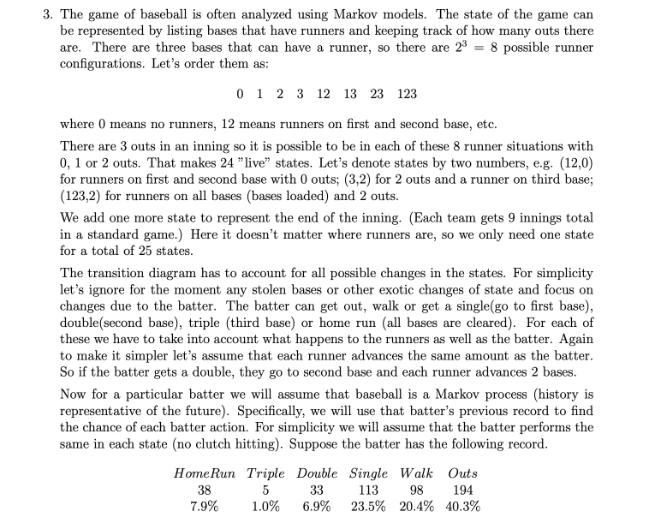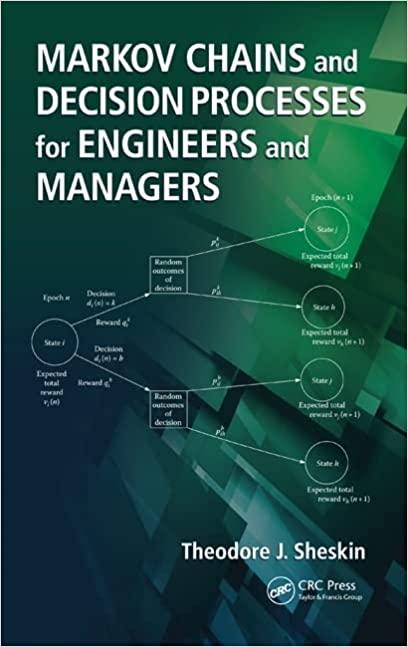3. The game of baseball is often analyzed using Markov models. The state of the game...
Fantastic news! We've Found the answer you've been seeking!
Question:


Transcribed Image Text:
3. The game of baseball is often analyzed using Markov models. The state of the game can be represented by listing bases that have runners and keeping track of how many outs there are. There are three bases that can have a runner, so there are 23 = 8 possible runner configurations. Let's order them as: 0 1 2 3 12 13 23 123 where 0 means no runners, 12 means runners on first and second base, etc. There are 3 outs in an inning so it is possible to be in each of these 8 runner situations with 0, 1 or 2 outs. That makes 24 "live" states. Let's denote states by two numbers, e.g. (12,0) for runners on first and second base with 0 outs; (3,2) for 2 outs and a runner on third base; (123,2) for runners on all bases (bases loaded) and 2 outs. We add one more state to represent the end of the inning. (Each team gets 9 innings total in a standard game.) Here it doesn't matter where runners are, so we only need one state for a total of 25 states. The transition diagram has to account for all possible changes in the states. For simplicity let's ignore for the moment any stolen bases or other exotic changes of state and focus on changes due to the batter. The batter can get out, walk or get a single(go to first base), double(second base), triple (third base) or home run (all bases are cleared). For each of these we have to take into account what happens to the runners as well as the batter. Again to make it simpler let's assume that each runner advances the same amount as the batter. So if the batter gets a double, they go to second base and each runner advances 2 bases. Now for a particular batter we will assume that baseball is a Markov process (history is representative of the future). Specifically, we will use that batter's previous record to find the chance of each batter action. For simplicity we will assume that the batter performs the same in each state (no clutch hitting). Suppose the batter has the following record. Home Run Triple Double Single Walk Outs 38 7.9% 5 1.0% 33 113 194 6.9% 23.5% 20.4% 40.3% 98 Questions: (a) Draw the portion of the state transition diagram that is relevant for starting in the state (23,1). Draw each state this state can move to with an arrow labeled by what type of batter action gives rise to that transition. (b) Write the column of the resulting transition matrix corresponding to the state (23,1). Identify each row of the column. (c) Does this model have a regular transition matrix? If so describe why it is regular, if not describe why it is not regular. (d) There are two majors changes that you can make to a Markov model. You can change the states (add, remove, combine, etc) and you can change the transition probabilities (the elements in the transition matrix). Which would you need to do to change this model to include all nine innings of a baseball game? Which would be needed to account for runners advancing more than one base on a single? 3. The game of baseball is often analyzed using Markov models. The state of the game can be represented by listing bases that have runners and keeping track of how many outs there are. There are three bases that can have a runner, so there are 23 = 8 possible runner configurations. Let's order them as: 0 1 2 3 12 13 23 123 where 0 means no runners, 12 means runners on first and second base, etc. There are 3 outs in an inning so it is possible to be in each of these 8 runner situations with 0, 1 or 2 outs. That makes 24 "live" states. Let's denote states by two numbers, e.g. (12,0) for runners on first and second base with 0 outs; (3,2) for 2 outs and a runner on third base; (123,2) for runners on all bases (bases loaded) and 2 outs. We add one more state to represent the end of the inning. (Each team gets 9 innings total in a standard game.) Here it doesn't matter where runners are, so we only need one state for a total of 25 states. The transition diagram has to account for all possible changes in the states. For simplicity let's ignore for the moment any stolen bases or other exotic changes of state and focus on changes due to the batter. The batter can get out, walk or get a single(go to first base), double(second base), triple (third base) or home run (all bases are cleared). For each of these we have to take into account what happens to the runners as well as the batter. Again to make it simpler let's assume that each runner advances the same amount as the batter. So if the batter gets a double, they go to second base and each runner advances 2 bases. Now for a particular batter we will assume that baseball is a Markov process (history is representative of the future). Specifically, we will use that batter's previous record to find the chance of each batter action. For simplicity we will assume that the batter performs the same in each state (no clutch hitting). Suppose the batter has the following record. Home Run Triple Double Single Walk Outs 38 7.9% 5 1.0% 33 113 194 6.9% 23.5% 20.4% 40.3% 98 Questions: (a) Draw the portion of the state transition diagram that is relevant for starting in the state (23,1). Draw each state this state can move to with an arrow labeled by what type of batter action gives rise to that transition. (b) Write the column of the resulting transition matrix corresponding to the state (23,1). Identify each row of the column. (c) Does this model have a regular transition matrix? If so describe why it is regular, if not describe why it is not regular. (d) There are two majors changes that you can make to a Markov model. You can change the states (add, remove, combine, etc) and you can change the transition probabilities (the elements in the transition matrix). Which would you need to do to change this model to include all nine innings of a baseball game? Which would be needed to account for runners advancing more than one base on a single?
Expert Answer:

Related Book For 

Markov Chains And Decision Processes For Engineers And Manager
ISBN: 9781420051117
1st Edition
Authors: Theodore J. Sheskin
Posted Date:
Students also viewed these mathematics questions
-
DON'T SUMMARIZE JUST PARAGRAPH OF WHAT YOU THOUGHT/LEARNED CHAPTER 13 - The phrase "garbage in, garbage out" highlights the importance of input controls. If the data entered into a system are...
-
THIRD AVENUE SOFTWARE HEALTH-CARE APP PROJECT This case is new for the ninth edition of Information Technology Project Management . The case provides an opportunity to apply agile and Scrum...
-
Perpetual inventory using FIFO Beginning inventory, purchases, and sales for Item Zeta9 are as follows: Oct. 1 Inventory 37 units @ $19 Oct. 7 Sale Oct. 15 Purchase Oct. 24 Sale Assuming a perpetual...
-
Let the number of successes X have a binomial distribution with n = 25 and p = .6 (a) Find the exact probabilities of each of the following: X = 17 11 < X < 18 11 < X < 18 (b) Apply the normal...
-
Godfreid Company has accounts receivable of $95,400 at March 31, 2020. Credit terms are 2/10, n/30. At March 31, 2020, there is a $2,100 credit balance in Allowance for Doubtful Accounts prior to...
-
Complete the second half of the proof of the "forward price formula with carrying cost". To construct the arbitrage, go long one unit of a forward and short one unit spot. To execute the short, it is...
-
The following variable production costs apply to goods made by Raeburn Manufacturing Corporation: Item Cost per Unit Materials ............... $ 8.00 Labor ............... 3.50 Variable overhead...
-
The big mall near Sally and Amy's city has extended their operating hours to accommodate the huge crowds expected for the After Thanksgiving Sale. In their eagerness to beat the crowd, Sally forgets...
-
Find the sales tax, paid on purchases at the rate of 7% if tax varies directly with the total purchase price, p. How much sales tax is paid on a $495 computer purchase?
-
Construct phase variable form simulation diagram for the following transfer functions and develop state space model in matrix form (a) \(\mathrm{T}(s)=\frac{\mathrm{Y}(s)}{\mathrm{U}(s)}=\frac{10...
-
The SISO system with repeated characteristic roots is described by transfer function \[ \mathrm{T}(s)=\frac{\mathrm{Y}(s)}{\mathrm{U}(s)}=\frac{7 s^{3}}{(s+2)^{2}(s+6)^{2}} \] Find state space model...
-
For the system described by the state equation \[ \dot{x}=\left[\begin{array}{ccc} 0 & 1 & 0 \\ 0 & 0 & 1 \\ 0.5 & 1 & 2 \end{array}ight] x+\left[\begin{array}{l} 0 \\ 0 \\ 1 \end{array}ight] u \] if...
-
A system has poles at \(0.01 \mathrm{~Hz}, 1 \mathrm{~Hz}\) and \(80 \mathrm{~Hz}\); zeros at \(5 \mathrm{~Hz}, 100 \mathrm{~Hz}\) and \(200 \mathrm{~Hz}\). The approximate phase of the system...
-
The input-output transfer function of a plant \(\mathrm{H}(s)=\frac{100}{s(s+10)^{2}}\). The plant is placed in a unity negative feedback configuration as shown in the figure below. The signal flow...
-
Communication and motivation are important skills for managers to use to direct the activities of their employees. These tools are used to help connect employees' efforts to company strategies. in...
-
Show that, given a maximum flow in a network with m edges, a minimum cut of N can be computed in O(m) time.
-
Can the displacement of a persons trip be zero, yet the distance involved in the trip is nonzero? How about the reverse situation? Explain.
-
An object traveling at a constant velocity vo experiences a constant acceleration in the same direction for a period of time t. Then an acceleration of equal magnitude is experienced in the opposite...
-
You are told that a person has walked 750 m. What can you safely say about the persons final position relative to the starting point?

Study smarter with the SolutionInn App


